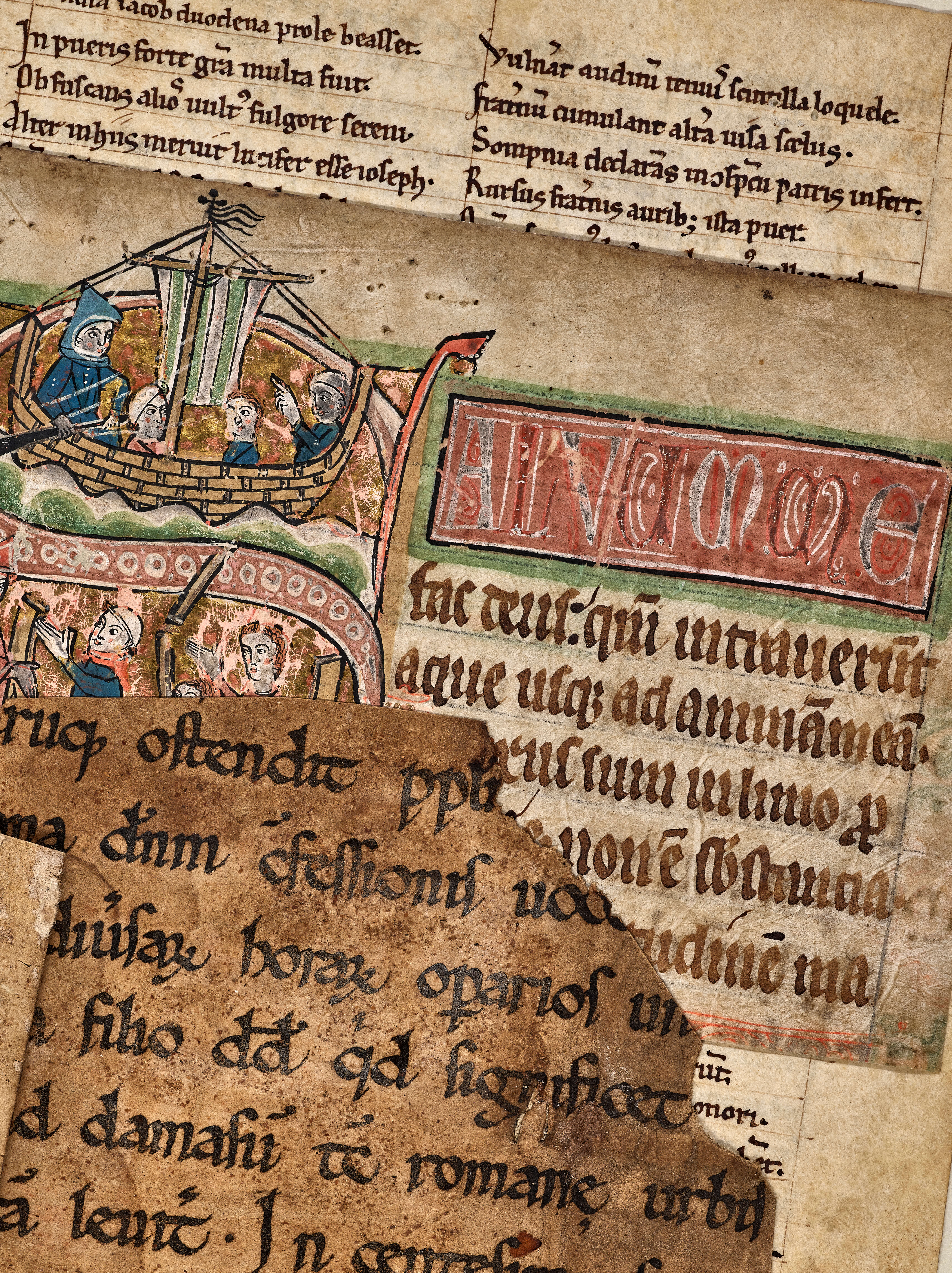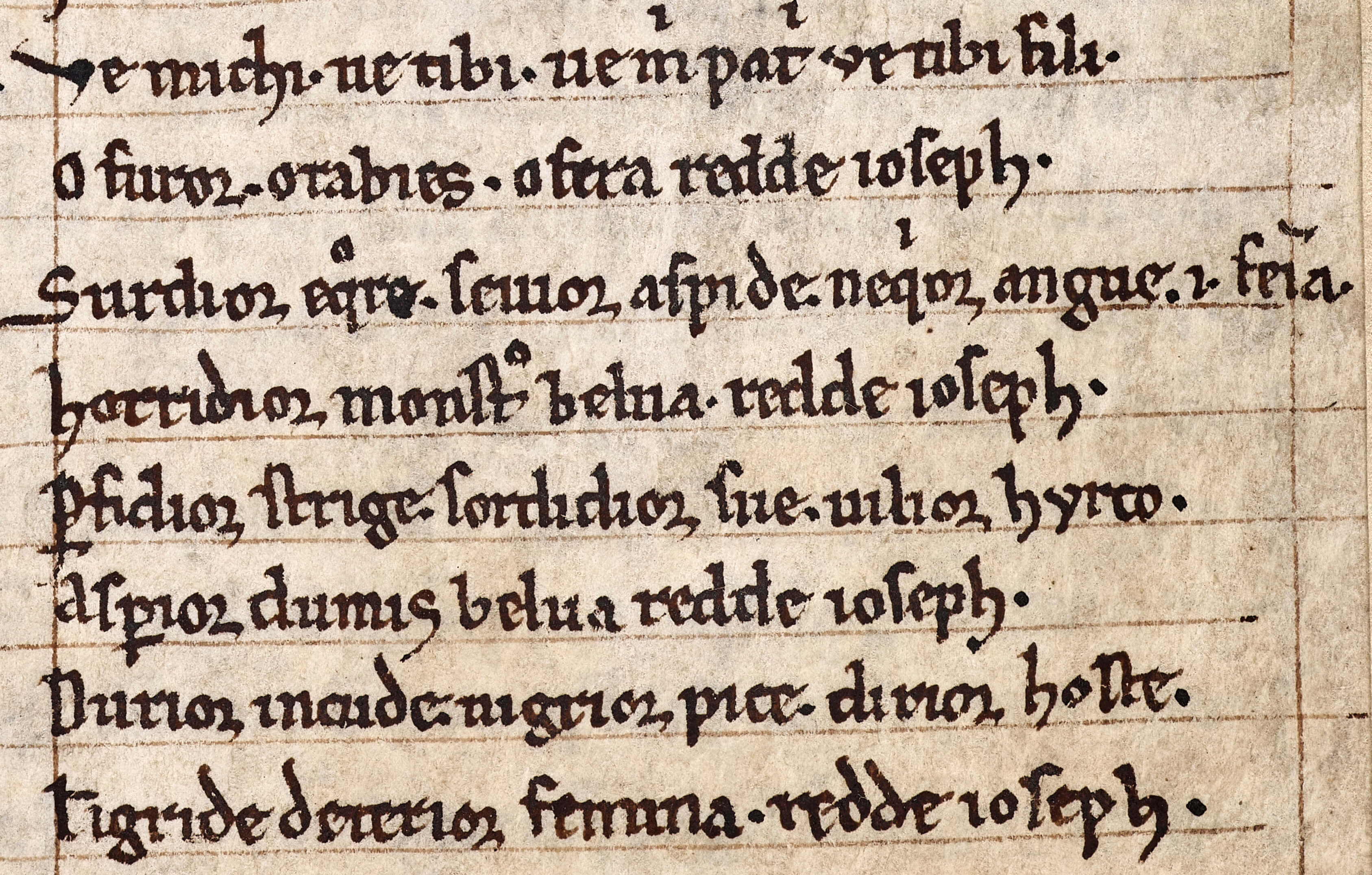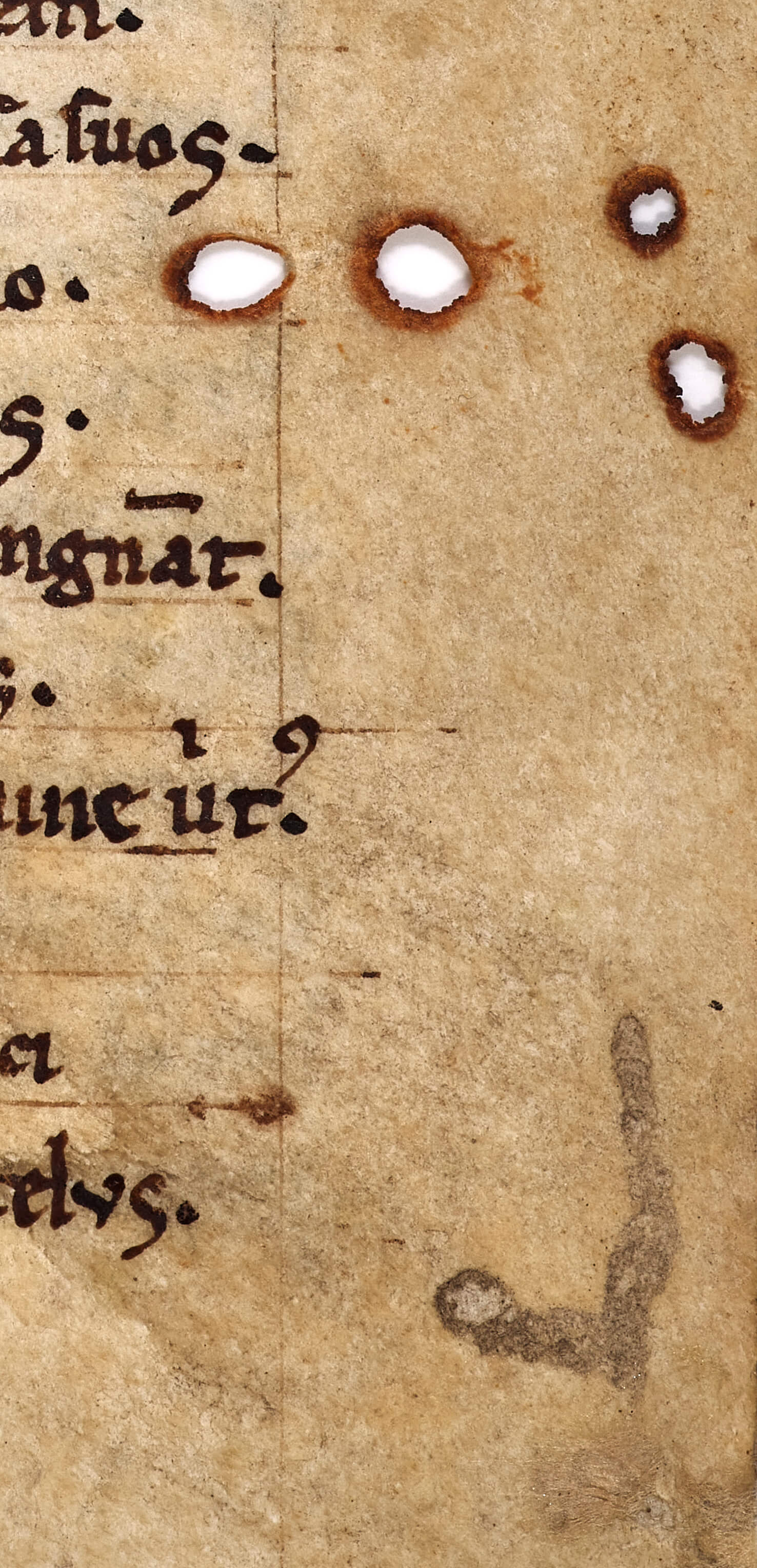An Educational Poem by Petrus Riga
The Arnamagnæan Collection houses many manuscript fragments which have not yet been identified. One of these previously unidentified fragments can now be shown to contain the educational poem De venditione Joseph by Petrus Riga.

An Unidentified Fragment
The fragment in question is one of three unrelated Latin fragments with the shelfmark AM 921 IX 4to. All three fragments contain religious texts. (A fourth fragment was transferred to another manuscript at an earlier point.) In his catalogue of manuscripts in the Arnamagnæan Collection, Kristian Kålund (1889-1894, ii 263–264) does not provide any detailed description of the individual fragments. However, he mentions that one of them, which has now received the individual shelfmark AM 921 IX 3 4to, contains an account in verse about Joseph and his brothers (”versificeret fortælling om Josef og hans brødre”). A closer look at the text reveals that the fragment contains the longer version of De venditione Joseph (“On the Selling of Joseph”), an educational poem on the biblical story of Joseph by the twelfth-century French poet Petrus Riga.
Petrus Riga’s educational poetry

Petrus Riga (ca. 1140–1209) was canon at the cathedral Notre-Dame de Reims and later canon regular at the Augustine Abbey Saint-Denis de Reims in France. He is best known for composing several popular educational poems in Latin on biblical topics.
A collection of his religious and secular poems, among them De venditione Joseph, was first compiled in ca. 1162 under the title Floridus aspectus (“Flowery View”). As the collection was received positively, Petrus Riga went on to compose his magnus opus Aurora (“Dawn”), written in the last quarter of the twelfth century. Aurora combines some his earlier poems included in Floridus aspectus with new material in an extensive allegorical verse commentary on the entire Bible in verse. Aurora was extremely popular in the Middle Ages and survives in an astonishing number of copies: In his edition of the text, Paul Beichner (1965) counts 248 surviving manuscripts. Since then, several more have been identified.
Aurora was even popular as a school book in the Middle Ages. In thirteenth- and fourteenth-century England and France, it was used to teach not only Latin grammar and poetics but also Christian allegory and ethics (Beichner 1965, xxx–xxxv). A copy of Aurora is also known to have existed at the Augustine abbey on Viðey island, near modern day Reykjavík, in 1397. It is mentioned in an inventory list of the abbey’s library for that year, preserved as a cartulary or máldagi (DI, iv 111), where it is listed below the abbey’s schoolbooks (“j Skolabokumm”). Iceland followed European practices in using Petrus Riga’s work for educational purposes.
In contrast to the popular Aurora, Floridus aspectus survives only in a small number of manuscripts.
Floridus Aspectus or Aurora?
The fragment AM 921 IX 3 4to contains only a small amount of De venditione Joseph. Theoretically, it could have belonged to a manuscript of either Floridus aspectus or Aurora. As Aurora was far more widespread than Floridus aspectus, it would seem more probable that AM 921 IX 3 4to belonged to a manuscript of Aurora. However, the version transmitted in AM 921 IX 3 4to seems rather to correspond to the version of Floridus aspectus, ending in the following eight lines:

Ve michi. ue tibi. ue michi patri ve tibi fili.
O furor. o rabies. o fera redde ioseph.
Surdior equore. seuior aspide. nequior angue.
Horridior monstro belua. redde ioseph.
Perfidior strige. sordidior sue. uilior hyrco.
Asperior dumis belua redde ioseph.
Durior incude. nigrior et pice. durior hoste.
Tigride deterior femina. redde Ioseph.
According to Paul Beichner (1969, 459), these lines are only included in the version of the poem transmitted in Floridus aspectus. Petrus Riga did not retain these lines in Aurora but replaced them with an alternative ending. As the lines are included in AM 921 IX 3 4to, we can therefore conclude that the fragment was part of a manuscript containing Floridus aspectus.
Back to the Codex
The original codex that AM 921 IX 3 4to once was part of does not survive. However, the different physical properties of the surviving fragment give us some insights into the provenance and later history of the lost codex.
The first line of each column is written on the top line of the ruling. This suggests that the manuscript has been written before 1220–40 when scribes started to instead write the first line of a folio beneath the top line of the ruling. The script of the fragment, a gothic textualis, seems to support such a dating. While the script does not provide any clear evidence for the place of origin of the manuscript, it seems to point to Western Europe.
Several forms of minor damage indicate that AM 921 IX 3 4to may have been used as a pastedown in the binding of another book. In this case, the recto side would have been the side pasted down. In the outer margin of the folio, there are eight rust holes: four in the upper part and four in the lower part. These holes were likely caused by two iron clasps with the rust eating through both the book board and the pastedown.
In addition, there is a small L-shaped damaged area at the lower fore-edge of the folio. This damage may have been caused by a kind of furniture beetle (Anobium punctatum) who ate his way through the wooden book board under the pastedown. The L-shaped damage may then indicate the area where the pastedown was directly glued to the book board whereas, in the surrounding area, a leather cover may have been in between the pastedown and the book board.

Topics
Contact
 Tom Lorenz is a Ph.D. candidate at the Norwegian University of Science and Technology in Trondheim.
Tom Lorenz is a Ph.D. candidate at the Norwegian University of Science and Technology in Trondheim.
Bibliography
Beichner, Paul (ed.). 1965. Aurora: Petri Rigate Biblia Versificata. A Verse Commentary on the Bible. University of Notre Dame Press.
Beichner, Paul. 1969. “The Floridus Aspectus of Peter Riga and some Relationships to the Aurora.” Classica et mediaevalia 30, 451–481.
DI = Jón Sigurðsson et al. (ed.). 1857–1972. Diplomatarium Islandicum. København.
Islandia Latina. A database of Latin authors, texts and manuscripts known and used in medieval Iceland. URL: https://www.islandialatina.hum.ku.dk
Kålund, Kristian. 1889-1894. Katalog over den Arnamagnæanske håndskriftsamling. 2 bind. København.
Contribute to Manuscript of the Month
Have something to say about one or more manuscripts in the Arnamagnæn Collection? Contribute to the column Manuscript of the Month to get your research out there! Write to Seán Vrieland (sean.vrieland@hum.ku.dk) for more details.
